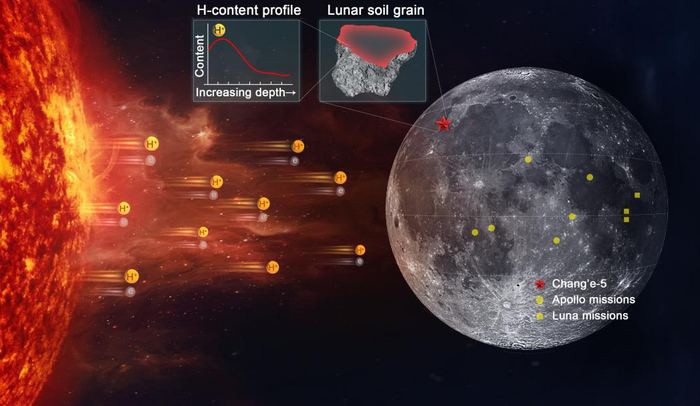Water on the Moon has been a hot topic in the research world lately. Since its first unambiguous discovery back in 2008. Since then, findings of it have ramped up, with relatively high concentration levels being discovered, especially near the polar regions, particularly in areas constantly shrouded in shadow. Chang’e 5, China’s recent sample return mission, didn’t land in one of those permanently shadowed areas. Still, it did return soil samples that were at a much higher latitude than any that had been previously collected. Now, a new study shows that those soil samples contain water and that the Sun’s solar wind directly impacted that water.
The amount of water on the lunar surface varies widely both based on the time of the lunar day and the latitude it is located at. There is so much variability that the water content of the lunar soil can be 200 ppm higher or lower at different times of the day. With that much variability, it seems clear that the Sun plays a significant role in the hydrological cycle there is on the Moon.
Part of that role is controlling the type of hydrogen embedded into the lunar soil. Since the Moon has almost no atmosphere to speak of, the charged hydrogen particles that make up the solar wind can directly interact with the top regolith layer on the lunar surface. When they do so, they leave behind a distinct sign that they do – a large amount of hydrogen atoms with very little deuterium.
Deuterium is a heavier form of hydrogen with an extra neutron in its nucleus. It is relatively rare on the solar wind, given that the neutron gives the extra mass, making it less likely to be caught up in the forces that create the wind. As such, hydrogen and whatever water it eventually forms from the solar wind would be distinctly lacking in water molecules that integrate deuterium.
That is exactly what researchers at the Chinese Academy of Sciences found on some of the soil samples returned by Chang’e 5. They had a high (~1000-2500 ppm) concentration of hydrogen but a relatively low concentration of deuterium. Importantly, this result was the case for the first 100 nm of soil collected, showing that the solar wind effect appears on the topmost layer of the regolith, as expected.
Also, the overall water concentration in the Chang’e 5 sample was estimated to be around 46 ppm, right around what was found using remote sensing prior to the lander touching down. Location also mattered a lot to this study, as the researchers attempted to use the concentration findings and feed them into a model that tracks the outgassing that was evidenced by lunar water at other latitudes. At the higher latitudes of Chang’e 5, there wasn’t as much variability as was found at lower latitudes by missions such as Apollo and Luna.
More importantly, the model also suggests that even higher latitudes, reaching up toward the poles, would have an even greater abundance of hydrogen. That lends credence to the theory that the lunar poles are one of the most likely places to find large amounts of water on the lunar surface. And it also feeds into the interest that the polar regions have garnered as the potential site of the first lunar research base. While that is still a long way off, the results from this study are an important step toward understanding this all-important feature of lunar hydrology.
Learn More:
CAS – Researchers discover solar wind-derived water in lunar soils
Xu et al. – High abundance of solar wind-derived water in lunar soils from the middle latitude
UT – Chang’e-5 Returned an Exotic Collection of Moon Rocks
UT – The Moon Could Have Gathered Some of its Water from the Earth’s Atmosphere
Lead Image:
Graphic depicting hydrogen flying onto the surface of the Moon on the back of the solar wind.
Credit – Prof. LIN Yangting’s group

